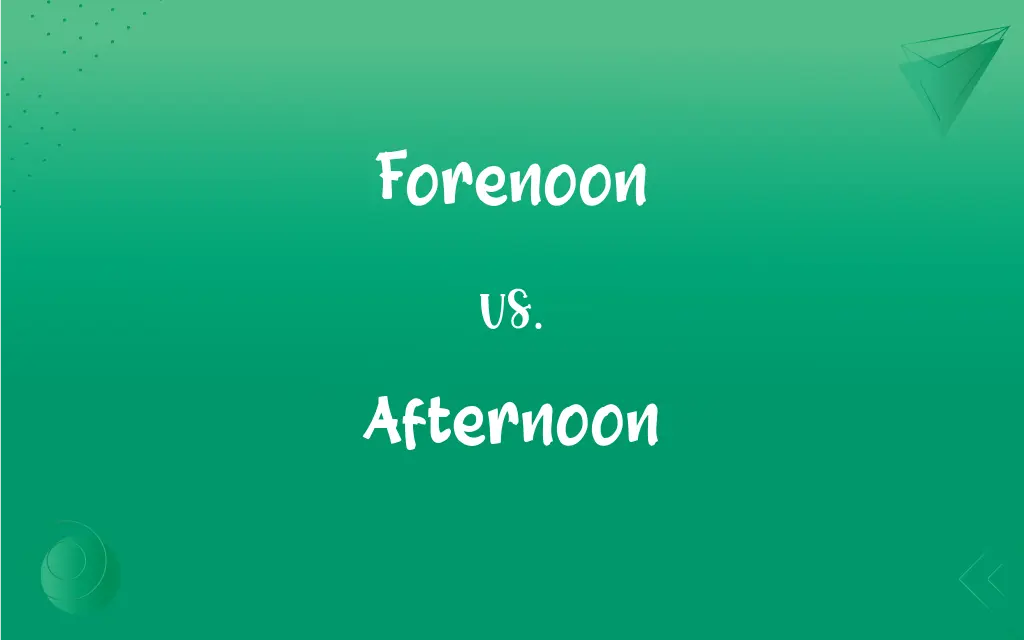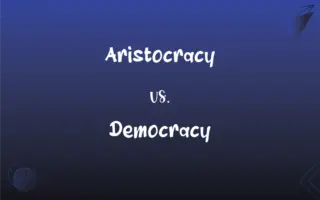Forenoon vs. Afternoon: What's the Difference?
Edited by Aimie Carlson || By Janet White || Updated on October 2, 2023
Forenoon refers to the period between morning and noon, while afternoon is the time between noon and evening.

Key Differences
Forenoon and afternoon delineate different segments of the day. Forenoon refers to the period after morning and before noon, typically spanning the hours between midmorning and 12:00 PM. It’s a term that pinpoints the latter part of the morning, often associated with the culmination of morning activities and preparations. Meanwhile, afternoon is the period that follows noon and precedes evening, typically encompassing the hours between 12:00 PM and 6:00 PM. It’s a timeframe synonymous with the post-lunch period and is often linked to a range of daytime activities, both professional and recreational.
While forenoon is a precise term that is less commonly used in daily conversations, it serves to distinctly identify the time segment closing the morning. It is often utilized for specific circumstances where precision regarding the morning hours is required, ensuring clarity about the latter part of the morning. On the other hand, afternoon is a more universally recognized and used term, indicating the time span post-noon. It’s a term that is integral to daily scheduling, professional appointments, and social engagements, helping to structure the day into discernable parts.
The concept of forenoon is integral to various cultures and traditions, reflecting the significance of the latter part of the morning in daily routines, rituals, and practices. It’s a time often dedicated to specific tasks, reflective contemplations, or preparatory activities, offering a balanced blend of the freshness of morning and the approaching zenith of the day. Conversely, the afternoon holds its own cultural, social, and traditional connotations, symbolizing a transition into the more relaxed or recreational part of the day, serving as a junction between the day’s vibrancy and the evening’s tranquility.
From a linguistic perspective, forenoon and afternoon represent the dynamic nature of language, with the prefix “fore-” denoting “before” and giving specificity to the morning time, while “after-” indicating the sequence post-noon. The nuanced differentiation between these terms helps in maintaining chronological clarity, offering explicit reference points for activities, events, and observations related to different periods of the day, highlighting the relative nature of time segments in daily discourse.
Lastly, the distinction between forenoon and afternoon is not just temporal but also holds relevance in the socio-cultural, professional, and linguistic domains, influencing perceptions, interactions, and interpretations of daily routines, societal norms, and communication practices. Utilizing these terms appropriately is essential for maintaining clarity, coherence, and cultural relevancy in conveying time-specific references, expressions, and intentions.
ADVERTISEMENT
Comparison Chart
Definition
Time between morning and noon.
Time between noon and evening.
Usage
Less common, more specific.
Universally recognized and used.
Time Frame
Between midmorning and 12:00 PM.
Between 12:00 PM and 6:00 PM typically.
Cultural Context
Associated with ending of morning activities.
Symbolizes transition to the evening.
Linguistic Prefix
“Fore-” means before.
“After-” means following in sequence.
ADVERTISEMENT
Forenoon and Afternoon Definitions
Forenoon
The hours approaching noon.
The forenoon sun is not as intense as the afternoon sun.
Afternoon
The segment of daylight after 12:00 PM.
The afternoon heat can be intense.
Forenoon
The time before midday.
The forenoon is often the most productive part of his day.
Afternoon
The period of time between noon and evening.
He takes a walk every afternoon.
Forenoon
The segment of the day after breakfast and before lunch.
The market is bustling in the forenoon.
Afternoon
The time following midday.
She has classes in the afternoon.
Forenoon
The period of time between morning and noon.
He completed his task in the forenoon.
Afternoon
The hours preceding the evening.
The park is beautiful in the afternoon.
Forenoon
The latter part of the morning.
She prefers to schedule meetings in the forenoon.
Afternoon
The part of day from noon until dinnertime or sunset.
Forenoon
The period of time between sunrise and noon; morning.
Afternoon
The latter part
In the afternoon of life.
Forenoon
Syn of morning: the part of the day between sunrise and noon.
Afternoon
The part of the day from noon or lunchtime until sunset, evening, or suppertime or 6pm.
Forenoon
The early part of the day, from morning to meridian, or noon.
Afternoon
(figuratively) The later part of anything, often with implications of decline.
Forenoon
The time period between dawn and noon;
I spent the morning running errands
Afternoon
(informal) A party or social event held in the afternoon.
Afternoon
In the afternoon.
Afternoon
Ellipsis of good afternoon
Afternoon
The part of the day which follows noon, between noon and evening.
Afternoon
The part of the day between noon and evening;
He spent a quiet afternoon in the park
Afternoon
A conventional expression of greeting or farewell
Afternoon
The part of the day after lunch.
The office is quieter in the afternoon.
FAQs
Can forenoon imply the early hours of the morning?
No, forenoon specifically refers to the time between midmorning and noon.
Is the term forenoon antiquated?
While less common, it isn’t considered antiquated and is still understood.
Is forenoon used globally?
It may be understood globally, but its usage can vary depending on regional language preferences.
Can afternoon refer to the entire time between noon and midnight?
Typically, it refers to the time between noon and evening, not extending to midnight.
Is forenoon only used for professional contexts?
No, it can be used in any context where specificity about the late morning is needed.
Does afternoon always refer to a relaxed or leisure time?
No, afternoon can involve various activities, both professional and leisurely.
Is forenoon commonly used in modern English?
It is less commonly used compared to afternoon, but it is understood and used for specificity.
Can afternoon refer to the whole day?
No, it specifically denotes the time period between noon and evening.
Can afternoon start before 12:00 PM?
No, afternoon specifically refers to the time following 12:00 PM.
Can forenoon and morning be used interchangeably?
No, as forenoon specifically refers to the latter part of the morning.
Can forenoon be used to refer to the early afternoon?
No, it specifically denotes the time period between midmorning and noon.
Is late afternoon considered evening?
It’s a transitional time but is generally still considered part of the afternoon.
Can the afternoon be considered the start of the day?
No, it is considered the middle segment of the day.
Does the afternoon include dinner time?
Typically, dinner time is considered part of the evening, not the afternoon.
Are forenoon and pre-noon the same?
Essentially, yes, both refer to the time period before noon.
About Author
Written by
Janet WhiteJanet White has been an esteemed writer and blogger for Difference Wiki. Holding a Master's degree in Science and Medical Journalism from the prestigious Boston University, she has consistently demonstrated her expertise and passion for her field. When she's not immersed in her work, Janet relishes her time exercising, delving into a good book, and cherishing moments with friends and family.
Edited by
Aimie CarlsonAimie Carlson, holding a master's degree in English literature, is a fervent English language enthusiast. She lends her writing talents to Difference Wiki, a prominent website that specializes in comparisons, offering readers insightful analyses that both captivate and inform.
































































